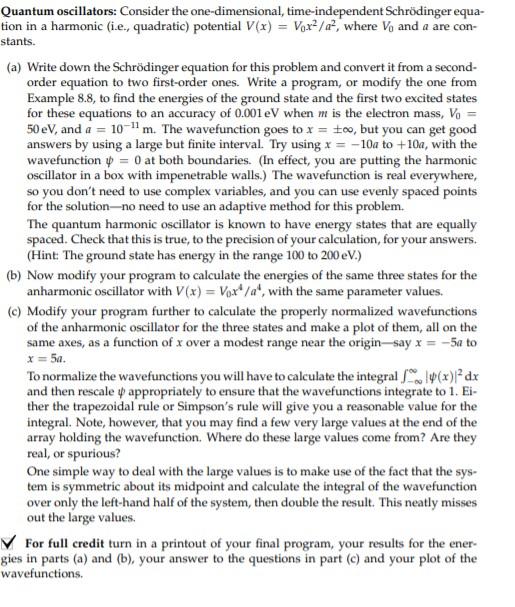Answered step by step
Verified Expert Solution
Question
1 Approved Answer
Jupyter Python Quantum oscillators: Consider the one-dimensional, time-independent Schrdinger equa- tion in a harmonic (i..., quadratic) potential V(x) = Vox?/d, where V and a are

Jupyter Python
Quantum oscillators: Consider the one-dimensional, time-independent Schrdinger equa- tion in a harmonic (i..., quadratic) potential V(x) = Vox?/d, where V and a are con- stants. (a) Write down the Schrdinger equation for this problem and convert it from a second- order equation to two first-order ones. Write a program, or modify the one from Example 8.8, to find the energies of the ground state and the first two excited states for these equations to an accuracy of 0.001eV when m is the electron mass, Vo 50 eV, and a = 10-11 m. The wavefunction goes to x = too, but you can get good answers by using a large but finite interval. Try using * = -10a to +100, with the wavefunction y = 0 at both boundaries. (In effect, you are putting the harmonic oscillator in a box with impenetrable walls.) The wavefunction is real everywhere, so you don't need to use complex variables, and you can use evenly spaced points for the solutionno need to use an adaptive method for this problem. The quantum harmonic oscillator is known to have energy states that are equally spaced. Check that this is true, to the precision of your calculation, for your answers. (Hint: The ground state has energy in the range 100 to 200 eV.) (b) Now modify your program to calculate the energies of the same three states for the anharmonic oscillator with V(x) = Vox* /a", with the same parameter values. (c) Modify your program further to calculate the properly normalized wavefunctions of the anharmonic oscillator for the three states and make a plot of them, all on the same axes, as a function of x over a modest range near the originsay x = -5a to * = 5a. To normalize the wavefunctions you will have to calculate the integral - 4(x) dx and then rescale 4 appropriately to ensure that the wavefunctions integrate to 1. Ei- ther the trapezoidal rule or Simpson's rule will give you a reasonable value for the integral. Note, however, that you may find a few very large values at the end of the array holding the wavefunction. Where do these large values come from? Are they real, or spurious? One simple way to deal with the large values is to make use of the fact that the sys- tem is symmetric about its midpoint and calculate the integral of the wavefunction over only the left-hand half of the system, then double the result. This neatly misses out the large values. For full credit turn in a printout of your final program, your results for the ener- gies in parts (a) and (b), your answer to the questions in part (e) and your plot of the wavefunctions. Quantum oscillators: Consider the one-dimensional, time-independent Schrdinger equa- tion in a harmonic (i..., quadratic) potential V(x) = Vox?/d, where V and a are con- stants. (a) Write down the Schrdinger equation for this problem and convert it from a second- order equation to two first-order ones. Write a program, or modify the one from Example 8.8, to find the energies of the ground state and the first two excited states for these equations to an accuracy of 0.001eV when m is the electron mass, Vo 50 eV, and a = 10-11 m. The wavefunction goes to x = too, but you can get good answers by using a large but finite interval. Try using * = -10a to +100, with the wavefunction y = 0 at both boundaries. (In effect, you are putting the harmonic oscillator in a box with impenetrable walls.) The wavefunction is real everywhere, so you don't need to use complex variables, and you can use evenly spaced points for the solutionno need to use an adaptive method for this problem. The quantum harmonic oscillator is known to have energy states that are equally spaced. Check that this is true, to the precision of your calculation, for your answers. (Hint: The ground state has energy in the range 100 to 200 eV.) (b) Now modify your program to calculate the energies of the same three states for the anharmonic oscillator with V(x) = Vox* /a", with the same parameter values. (c) Modify your program further to calculate the properly normalized wavefunctions of the anharmonic oscillator for the three states and make a plot of them, all on the same axes, as a function of x over a modest range near the originsay x = -5a to * = 5a. To normalize the wavefunctions you will have to calculate the integral - 4(x) dx and then rescale 4 appropriately to ensure that the wavefunctions integrate to 1. Ei- ther the trapezoidal rule or Simpson's rule will give you a reasonable value for the integral. Note, however, that you may find a few very large values at the end of the array holding the wavefunction. Where do these large values come from? Are they real, or spurious? One simple way to deal with the large values is to make use of the fact that the sys- tem is symmetric about its midpoint and calculate the integral of the wavefunction over only the left-hand half of the system, then double the result. This neatly misses out the large values. For full credit turn in a printout of your final program, your results for the ener- gies in parts (a) and (b), your answer to the questions in part (e) and your plot of the wavefunctionsStep by Step Solution
There are 3 Steps involved in it
Step: 1

Get Instant Access to Expert-Tailored Solutions
See step-by-step solutions with expert insights and AI powered tools for academic success
Step: 2

Step: 3

Ace Your Homework with AI
Get the answers you need in no time with our AI-driven, step-by-step assistance
Get Started


